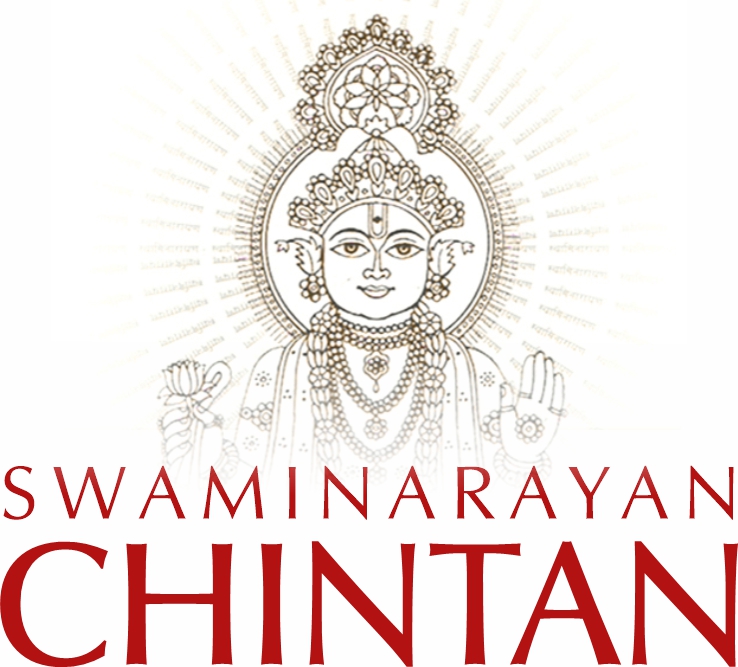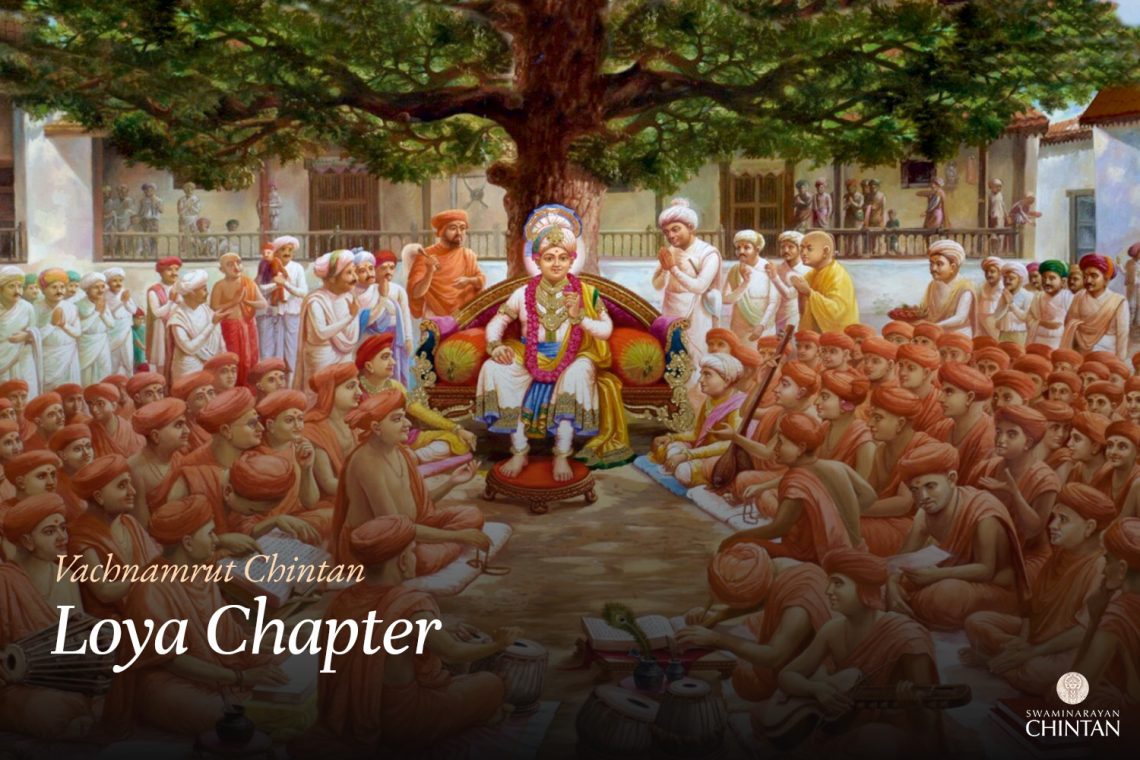Central Insights:
- The nature of the Jeevatma (individual soul) and the principles of Sankhya, Yog, and Vedant.
Main Points:
- The Jeev (soul) cannot act as the karta (doer) or bhokta (experiencer) without the support of the Indriyas (senses) and Antahkaran (inner faculties).
- Even though the soul is formless, Bhagwan Himself resides within it in a sakar (form) manner.
- The principle of Sankhya: Worship God by separating the Indriyas (senses) from the Antahkaran (inner faculties).
- The principle of Yog: Regulate the Indriyas (senses) and Antahkaran (inner faculties) properly and connect them with God.
- The principle of Vedant: Worship God by understanding His supreme glory.
Commentary:
This Vachanamrut begins with Maharaj’s merciful words. The Jeev pervades all bodies through Adhyatma (spiritual), Adhibhoot (material), and Adhidev (divine) principles. Adhyatma refers to the subtle body, as expressed in the phrase, “Atmani adhikrutya vartate iti adhyatmam,” where the word Atma refers to the mind. Hence, in this context, it refers to the entire subtle body. Adhibhoot pertains to the gross body and the physical senses, while Adhidev relates to the powers associated with deities, such as the power of sight, which is related to the sun (Surya). Therefore, these powers are referred to as deities or Adhidev. Maharaj explains that the soul’s experiences as the bhokta (experiencer) depend on these three aspects. The Jeev cannot directly experience objects, pleasure, or pain without relying on these three principles. Thus, the soul acts through these mediums to become the bhokta (experiencer). Without them, the soul cannot fulfill its role as an experiencer.
At this point, Nityanand Swami raised a concern, saying, “Maharaj, it is said that the Jeev is generally spread throughout the entire body but resides specifically in the space of the heart. So why is the experience of consciousness not uniform throughout the body?” This implies that the soul can act as the experiencer of sensory objects, pleasure, and pain through various mediums. But why is the experience not the same everywhere if the soul pervades equally?
Maharaj responds by explaining that the body, including the senses and Antahkaran, is composed of the Pancha Bhoota (five physical elements), and the Indriyas (senses) and Antahkaran (inner faculties) are formed from Ahamkar Tattva (ego element), which itself manifests in three forms: Sattva (purity), Rajas (activity), and Tamas (ignorance). Because of these variations in purity, the clarity of each component differs, which impacts the intensity of experience. The Jeev pervades uniformly, but due to the differing purity of the instruments of perception, the experience of consciousness is not equal in all parts of the body. As a result, greater or lesser degrees of perception occur in different places.
At that point, Brahmanand Swami asked, “Some perceive the Jeev as a star, some see it like a flame of light, and others see it like a flash of fireworks. How can this difference be explained?”
Maharaj replied, “For one who has mastered Akshividya (the art of concentration and control of the eyes), the Jeev is visible through the eyes, and within the soul, Bhagwan is also seen. However, the way the Atma (soul) is perceived depends on which Indriya (sense) the person is using to visualize it. Until one has attained an unobstructed vision, their perception remains partial. As a result, one may see only parts of the soul, but this cannot be considered true or perfect realization of the Atma. Maharaj gave the analogy of a glass statue and the sight of a cow, explaining that one can be said to have seen the soul but not in its entirety. Until one’s vision becomes completely unobstructed, it cannot be termed complete Atmadarshan (self-realization). Therefore, based on their experiences, different people perceive the soul in different ways. However, when true realization is attained, the vision of all souls will appear the same, as all souls are inherently identical in nature.”
At that point, Nityanand Swami asked, “You described the Jeev as formless (by giving the analogy of a glass statue), but is Bhagwan residing within the Jeev in a sakar (form) or nirakar (formless) manner?”
Maharaj replied, “Bhagwan, who resides within the Jeev, is indeed sakar, but He is not visible because the tendencies (vrittis) of the Jeev obstruct this vision. Bhagwan is always present in a murtiman (form) state.”
Then Nityanand Swami asked further, “Maharaj, when Paramatma resides within the Jeev, does He remain in the form of Purush or as Akshar or does He reside there Himself directly? Because the Shruti (revealed scriptures) say:
पुरुषेणात्मभूतेन वीर्यमाधत्त वीर्यवान्।
Purushenātmabhūtena vīryamādatta vīryavān |
(Bhagavatam. 3.5.26)
It states that Paramatma creates the universe through Purush, Aksharbrahm, and other elements. So, does Paramatma reside in the Jeev through these elements, or is He present directly?”
Maharaj replied, “Regardless of the form in which He resides, one must understand that it is Bhagwan Himself who is present. Whether He manifests as Purush, Akshar, or Purushottam, they all possess a similar divine luminosity. Therefore, distinguishing between them is extremely difficult. Only if Bhagwan showers His grace can this distinction be made; otherwise, it is impossible. Whether He resides as Purush or Akshar, they all operate under the complete control of Paramatma, suppressing their individual identities and working entirely in accordance with the will and commands of Paramatma. So, regardless of the form, one must understand that it is Bhagwan Himself who is performing these actions.”
Maharaj then spoke about the principles of Vedant, Yog, and Sankhya. These three philosophies explain the means to realize the form of Paramatma, Atmadarshan (self-realization), and Paramatmadarshan (God-realization), but their methods and reach vary slightly. In particular, Sankhya emphasizes the realization of the soul’s nature. Even though Sesvar Sankhya acknowledges the worship of Paramatma, Maharaj pointed out that while Sankhya outlines the means, it does not explicitly state that the Atma is separate from the 24 Tattvas (basic elements). This should be understood as a silent implication. Since the means are explained, it implies that the Atma, which is the performer of these practices, is distinct from the 24 Tattvas. One must practice accordingly, with the understanding that Paramatma is to be worshipped.”
“On the other hand, in Yog, the Jeev is considered separate from the 24 Tattvas, and the 25th element is Paramatma, on whom the mind is to be focused. In Sankhya, the Indriyas (senses) and Antahkaran (inner faculties) are not considered one’s own, while in Yog, they are considered one’s own, and thus must be regulated. Hence, the follower of Yog treads cautiously, while the follower of Sankhya remains fearless. The follower of Vedant, however, understands the immense glory of Bhagwan and worships Him. From another perspective, the reach of Sankhya is up to Purush, Yog reaches up to Hiranyagarbha, and Vedant worship ultimately reaches Paramatma.”
Glossary
| Jeev – Soul |
| Karta – Doer The soul as the doer of actions, but it relies on the senses and the inner faculties to carry out these actions. |
| Bhokta – Experiencer The soul as the experiencer of sensory objects, pleasure, or pain through the body and senses. |
| Indriyas – Senses The five sense organs (Eyes, Ears, Nose, Tongue, Skin) through which external knowledge is received. |
| Antahkaran – Inner faculties The mind, intellect, consciousness, and ego, which help in acquiring spiritual knowledge. |
| Adhyatma – Spiritual body Refers to the subtle body or mind, which pervades the material body and governs spiritual perception. |
| Adhibhoot – Physical body The gross, material body and physical senses, which are influenced by the elements of nature. |
| Adhidev – Divine powers The divine powers or deities associated with natural elements like sight, often represented by gods or goddesses. |
| Sankhya – A school of philosophy A philosophical system that explains the nature of the soul and the universe, emphasizing the distinction between the soul (Atma) and the material world. |
| Yog – Union or spiritual practice A philosophical and practical discipline aimed at achieving union with the divine through meditation, control of senses, and spiritual focus. |
| Vedant – The end of the Vedas A school of philosophy based on the teachings of the Vedas, emphasizing the realization of the supreme reality (Brahman) and the unity of the soul with it. |
| Akshividya – The art of concentration The skill of focusing the mind and senses, particularly the control of vision, to perceive spiritual truths. |
| Vrittis – Mental tendencies The fluctuations or movements of the mind that can either distract from or support spiritual practice. |
| Murti – Divine form of God |
| Purush – Cosmic Being A concept in spiritual philosophy referring to the supreme being or universal soul that is the source of creation. |
| Akshar – Eternal Entity The highest spiritual reality beyond material existence, often associated with Bhagwan’ Swaminarayans divine abode. |
| Purushottam – Supreme God A term used to refer to the highest, most perfect form of God, often associated with Bhagwan Swaminarayan. |
| Purushartha – Personal effort |
| Hiranyagarbha – A entity in Vedanta philosophy representing the source of creation from which the universe emerges. |
| Paramatma – Supreme God God, the all-pervading and ultimate reality. |
| Atmadarshan – Self-realization The realization of the true nature of the self (Atma), recognizing it as distinct from the body and mind. |
| Paramatmadarshan – God- realization The realization or experience of God in His supreme form, often involving a direct connection with the divine. |
| Tattvas – Principles or elements The basic principles or elements of reality in Sankhya and Yog philosophy, which make up the material and spiritual universe. |
| Purushabhava – The form of the divine The embodiment or manifestation of the divine in the material world, often referring to God’s descent into the world. |
| Sakar – With form Referring to God or the divine in a form that can be perceived by the senses, as opposed to the formless (Nirakar) aspect. |

